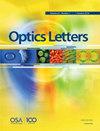Deep neural network for modeling soliton dynamics in the mode-locked laser.
IF 3.3
2区 物理与天体物理
Q2 OPTICS
引用次数: 17
Abstract
Integrating the information of the first cycle of an optical pulse in a cavity into the input of a neural network, a bidirectional long short-term memory (Bi_LSTM) recurrent neural network (RNN) with an attention mechanism is proposed to predict the dynamics of a soliton from the detuning steady state to the stable mode-locked state. The training and testing are based on two typical nonlinear dynamics: the conventional soliton evolution from various saturation energies and soliton molecule evolution under different group velocity dispersion coefficients of optical fibers. In both cases, the root mean square error (RMSE) for 80% of the test samples is below 15%. In addition, the width of the conventional soliton pulse and the pulse interval of the soliton molecule predicted by the neural network are consistent with the experimental results. These results provide a new insight into the nonlinear dynamics modeling of the ultrafast fiber laser.基于深度神经网络的锁模激光孤子动力学建模。
将光脉冲在空腔中的第一周期信息整合到神经网络的输入中,提出了一种具有注意机制的双向长短期记忆(Bi_LSTM)递归神经网络(RNN),用于预测孤子从失谐稳态到稳定锁模态的动力学。训练和测试基于两种典型的非线性动力学:不同饱和能下的常规孤子演化和不同光纤群速度色散系数下的孤子分子演化。在这两种情况下,80%的测试样本的均方根误差(RMSE)都低于15%。此外,神经网络预测的常规孤子脉冲宽度和孤子分子的脉冲间隔与实验结果一致。这些结果为超快光纤激光器的非线性动力学建模提供了新的认识。
本文章由计算机程序翻译,如有差异,请以英文原文为准。
求助全文
约1分钟内获得全文
求助全文
来源期刊

Optics letters
物理-光学
CiteScore
6.60
自引率
8.30%
发文量
2275
审稿时长
1.7 months
期刊介绍:
The Optical Society (OSA) publishes high-quality, peer-reviewed articles in its portfolio of journals, which serve the full breadth of the optics and photonics community.
Optics Letters offers rapid dissemination of new results in all areas of optics with short, original, peer-reviewed communications. Optics Letters covers the latest research in optical science, including optical measurements, optical components and devices, atmospheric optics, biomedical optics, Fourier optics, integrated optics, optical processing, optoelectronics, lasers, nonlinear optics, optical storage and holography, optical coherence, polarization, quantum electronics, ultrafast optical phenomena, photonic crystals, and fiber optics. Criteria used in determining acceptability of contributions include newsworthiness to a substantial part of the optics community and the effect of rapid publication on the research of others. This journal, published twice each month, is where readers look for the latest discoveries in optics.
 求助内容:
求助内容: 应助结果提醒方式:
应助结果提醒方式:


